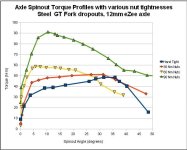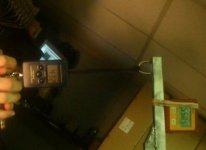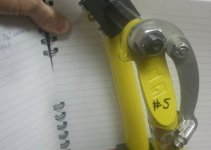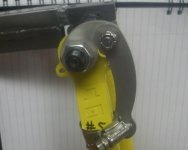el_walto said:
Would you recommended tightening the eZee hub motors to 90Nm? I'm afraid I might strip the threads, or even crush the aluminum dropouts on my bike.
I'm curious as to what is the maximum torque a standard axle/bolt starts to strip at.
ME TOO! I thought this would be a pretty straightforwards and easily reproducible experiment. We used an even larger wrench on the nut, and started pulling it tighter and tighter while reading the force on the load cell:
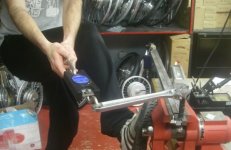
The length of the wrench was 27cm. We had to lever with the foot against the vise and were pulling with upwards of 105lb when finally, fwoomp, it seemed to give. 105 pounds is a huge amount of force to put on a big wrench like this, I couldn't imagine anyone tightening a nut on a bicycle that way, and translates to 125 Newton Meters.
Turned out that it wasn't the threads that gave way, it was the actual wrench splaying open and cornering off the axle nut:
View attachment 4
We took the nut off and the threads were still perfectly in tact, save for some shavings of metal plating that came off the nut.
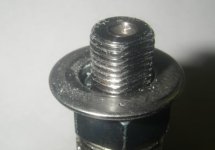
dequinox said:
Perhaps the axles Justin has are of a different alloy than the one's you work with. That might explain the stainless torque arms getting mutilated while the axle was less affected.
Yes, so all of Affliction's (Ben's) comments seem to be with regard to Crystalyte axles. Well we have some of those lying around too. So same test as above was done on a slightly used 400 series rear axle. The peak torque was 70 N-m when the nut started to spin freely. Definitely stripped threads:
View attachment 2
We then flipped the axle around to repeat the test on the other side to get a few more data points and get a sense for the repeatability. And guess what, on THIS side of the crystalyte axle, we had it all the way to 130 N-m when the wrench slipped and rounded the nut as above with the eZee axle.
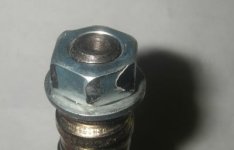
So, while one end of the Crystalyte axle stripped all it's threads at 70 N-m, this side withstood 130 N-m, with the threads still almost perfectly in tact:
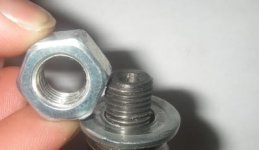
Not totally sure what to make of this. Either there is a huge variability in the temper on the Crystalyte axles, or more likely I think it is the mechanical tolerances on the axle threads, with one side being a looser fit in the nut and hence much more prone to stripping. In any case, we're going to need to purchase a real combination wrench set in order to properly complete these tests, as the adjustable one just isn't up for the torques involved.
Justin


